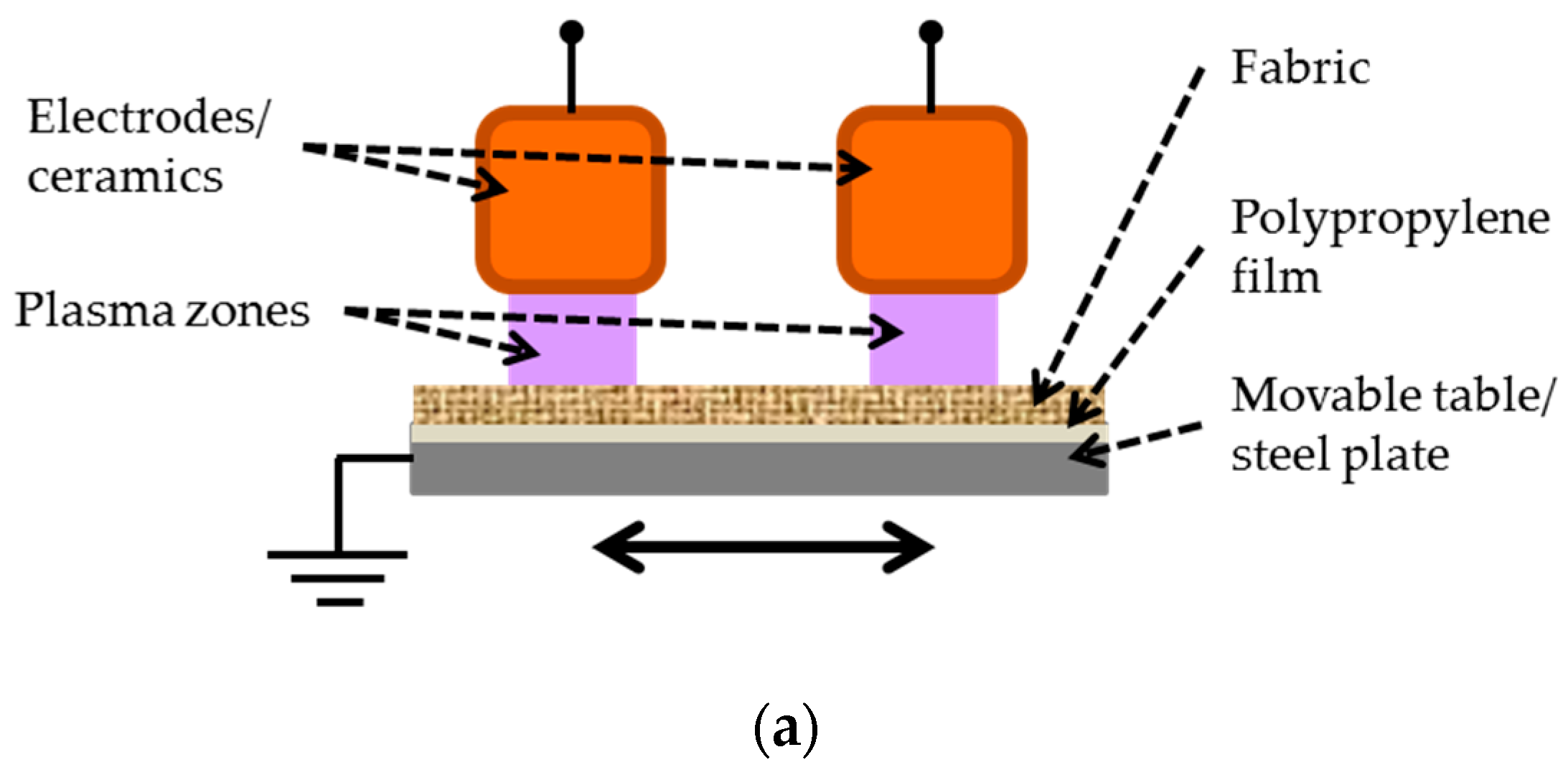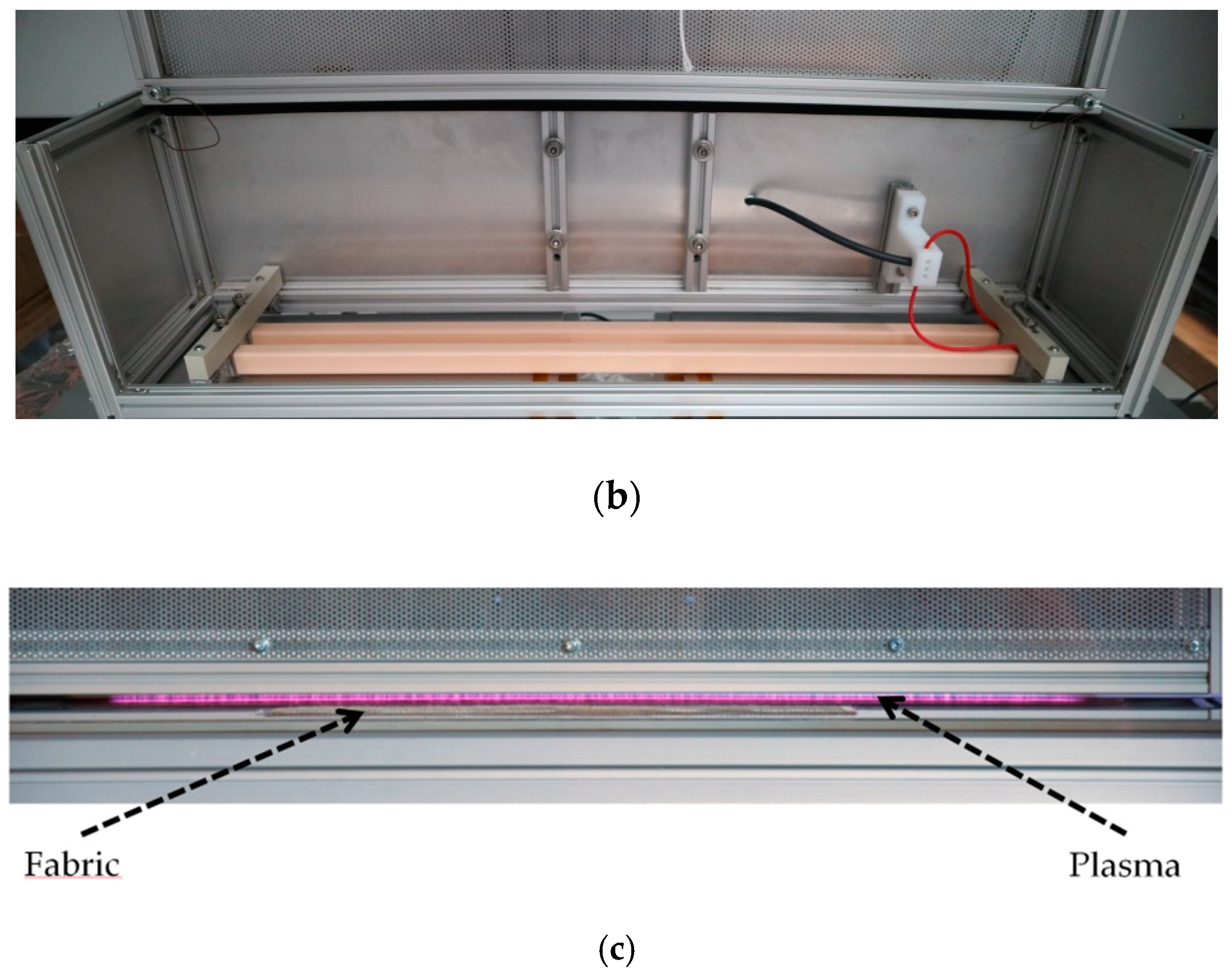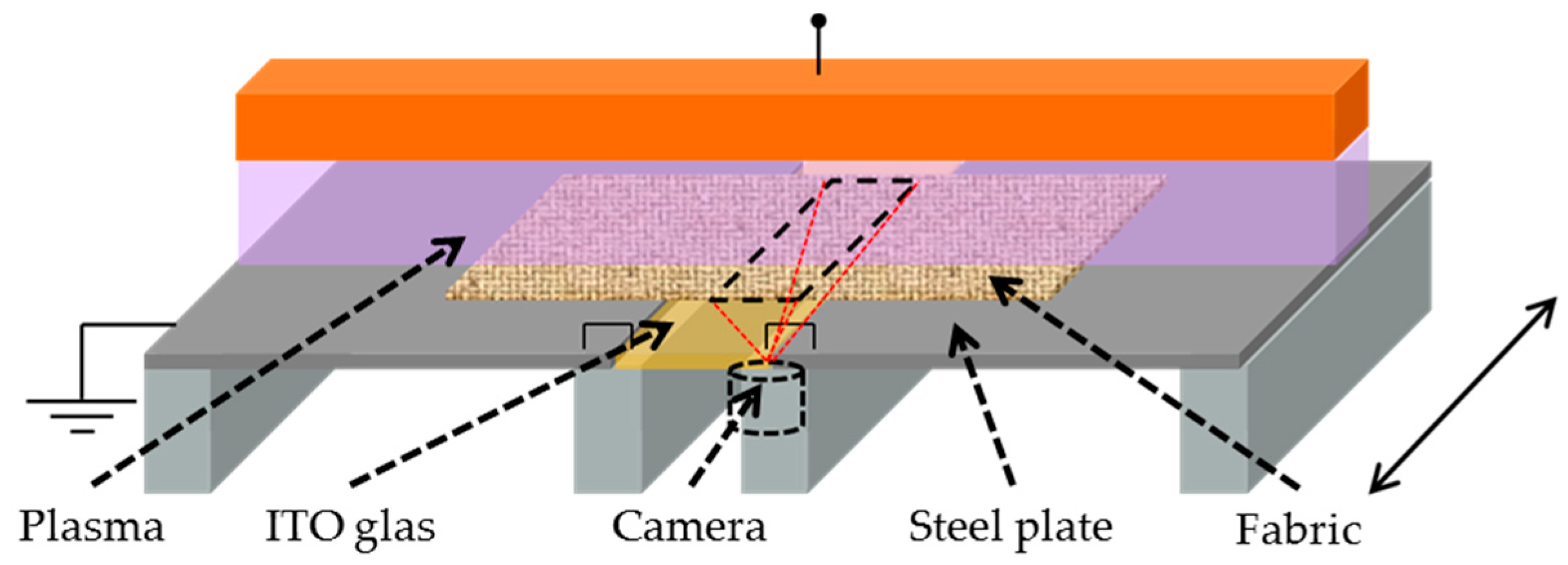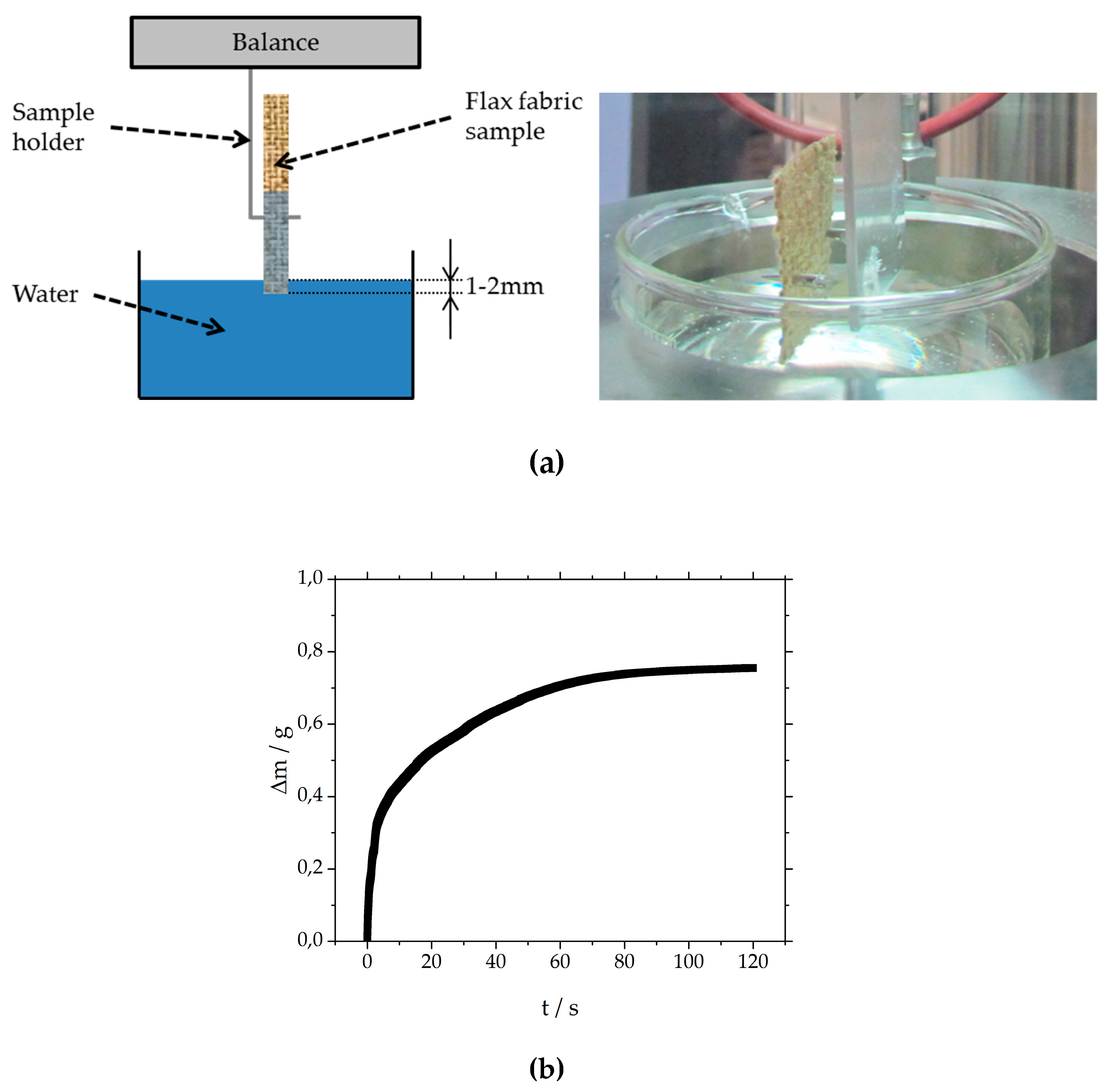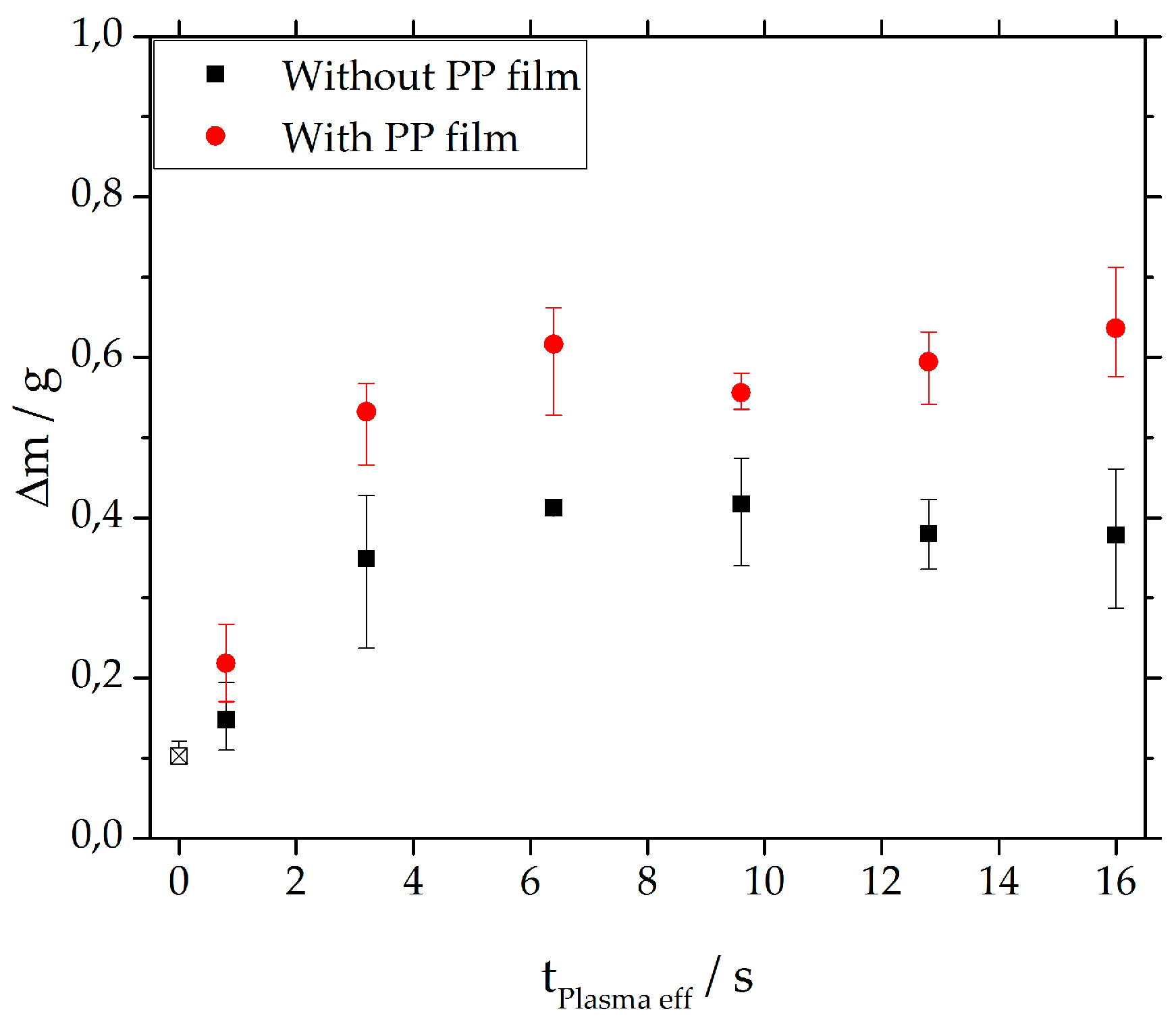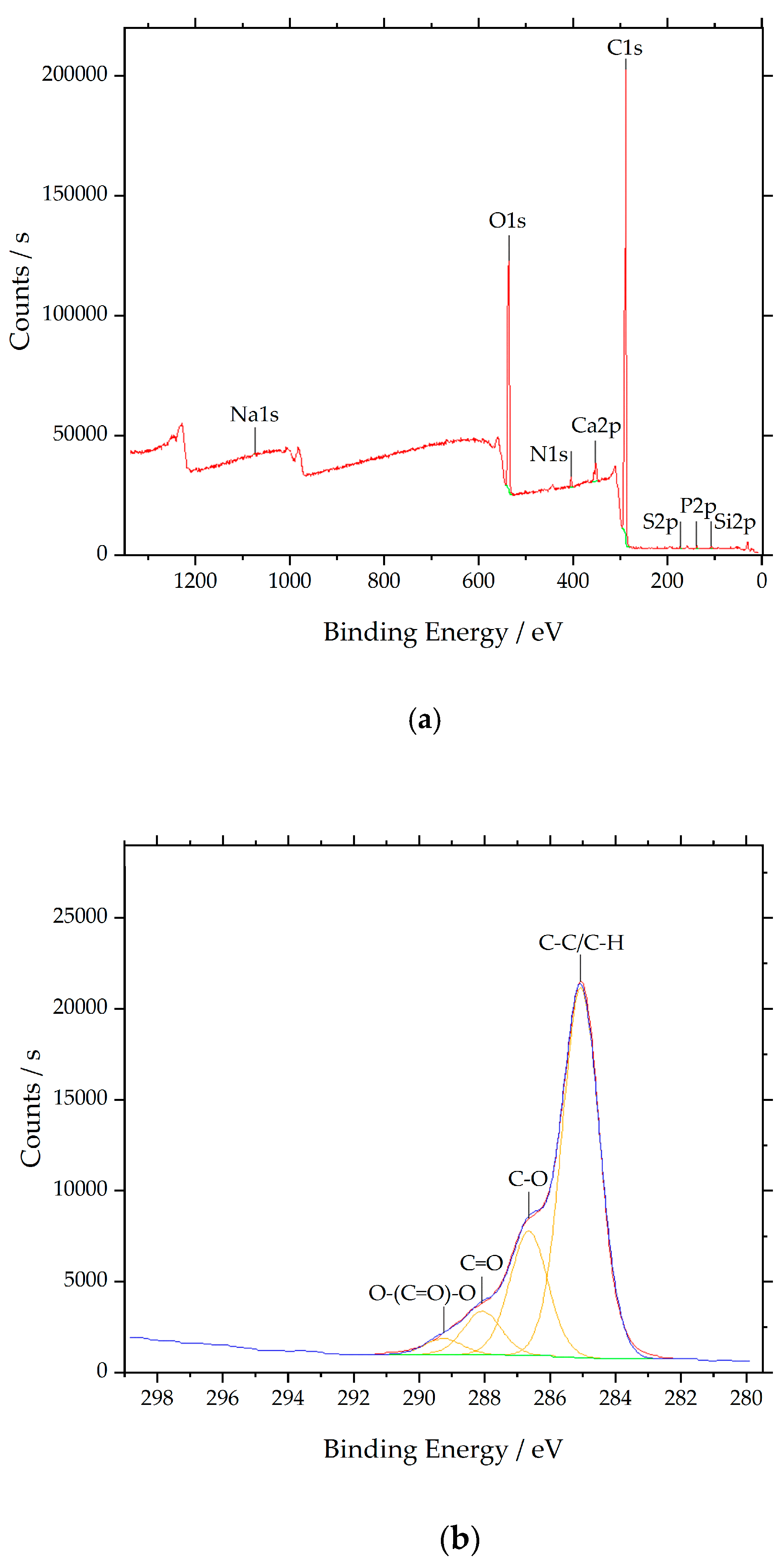1. Introduction
Today, natural fibers are widely used as an environmentally friendly, low-cost alternative in fiber reinforced composites [
1]. Fields of application are e.g., the automotive, leisure, and building industries [
2]. Amongst the available fiber types, flax offers a high specific strength, but, like many natural fibers, shows limitations in impregnation processes [
3]. Due to the natural character, the surfaces are highly heterogeneous and the surface properties vary significantly depending on the origin of the fibers. In addition to the main constituents (cellulose, hemicellulose, lignin, pectin), natural waxes, which reduce wettability, can also be found on the fiber surfaces (
Figure 1).
For above reasons, flax fibers are often not compatible with polymer matrix systems. Besides the treatment with wet chemicals/sizings, one way to adjust the compatibility is a dry plasma treatment of the fibers with a dielectric barrier discharge at atmospheric pressure, similar to studies performed on different natural fibers, such as cellulosic/cotton fibers [
4,
5]. Compared to other plasmas, dielectric barrier discharges (DBDs) have a lower thermal impact on the treated samples, which is preferable since flax fibers have a low thermal stability [
6].
With plasma, it is possible to modify the surface polarity, usually through the formation of oxygen containing functionalities and the topography of the fibers, which might lead to an improved impregnation with polymer matrices, as already shown by e.g., Bozaci et al. [
7]. With regard to industrial roll-to-roll processes, an atmospheric pressure dielectric barrier discharge (AP-DBD) source in plane configuration, with a treatment width of 600 mm, was used in this paper. It was investigated whether it is possible to achieve a homogenous increase of the functionalities on flax fabrics with the source operating in ambient air. Subsequently, it was examined whether the treatment effects can be further improved if the natural waxes are removed prior to the plasma treatment. After showing these results, an explanatory approach for the mechanism of formation of the functional groups is presented. The goal was to improve the understanding of the effect of fiber surface chemistry on the plasma treatment quality and to find possible ways to increase the degree and stability of the plasma activation, which would be beneficial for the fiber impregnation with polymer matrices.
2. Materials and Methods
2.1. Materials
In the experiments, a unidirectional flax fabric with an area weight of 435 g/m2 was used. Each fiber roving of the fabric consists of multiple twisted single fibers.
Prior to the plasma treatment, a portion of the fabric was washed in boiling acetone for at least 45 min to remove waxy substances (subsequently called “waxes”) from the fiber surfaces, similar to the process described by Aydin et al. [
9].
2.2. DBD Source Setup and Parameters
The flax fabric was treated with a DBD system from Tantec A/S. The system consists of two electrodes, which are embedded in ceramic profiles, and a generator (type HV-X20), plus a transformer (type HT-X2-13) with a maximum output power of 2 kW at 13 kV (frequency 13 kHz). The discharge is created between the electrodes and a grounded steel plate, which is placed on a movable table so that samples can be moved through the plasma zones, as shown in
Figure 2.
The treatments were performed at a constant generator power of 1 kW and a gap distance of 4 mm between the ceramics and the steel plate. The fabrics were treated with and without a polypropylene (PP) film (thickness 20 μm) underneath to investigate the influence of additional dielectrics on the intensity and homogeneity of the treatment. To evaluate the influence of exposure time, the samples were moved through the plasma zones with different repetitions (called cycle number Z), at a constant velocity of 50 mm/s. One cycle (Z = 1) corresponded to one passage under the electrodes, leading to effective plasma exposure times (tPlasma eff) of approximately 0.8 s per passage. After plasma treatment, the samples were stored in ambient conditions for around one day prior to analysis to let the moisture content of the treated fabrics and the reference fabrics readjust.
In order to examine the plasma penetration into the fabric, camera images were taken at 240 fps through a transparent Indium Tin Oxide (ITO) coated glass replacing the grounded steel plate. As can be seen in
Figure 3, the camera could be placed directly underneath the glass and fabric. The plasma parameters were the same as for the treatments mentioned above. Since the conductivity of the ITO coated glass differs from the conductivity of the steel plate, the discharges (with and without PP film) were compared only qualitatively, and the flax samples were not used for further analysis.
2.3. Water Uptake Measurements
Flax fabric samples with a size of 30 mm x 25 mm were attached to a sample holder with pins and perpendicularly immersed into water at approximately 1–2 mm, as shown in
Figure 4. Thereby, the sample weight change was recorded with the balance of a tensiometer (Dataphysics, Filderstadt, Germany) for 120 s. At least three measurements were done for each parameter.
2.4. X-ray Photoelectron Spectroscopy
The surfaces of flax fabrics and separated fiber components were analyzed with X-ray photoelectron spectroscopy (XPS) using a Thermo K-Alpha K1102 system (Thermo Fisher Scientific Inc., Waltham, MA, USA) with a pass energy of 150 eV for the acquisition of survey spectra and 40 eV for the acquisition of highly resolved spectra. Neutralization of the conductive fabric samples was achieved through a combination of low energy electrons and low energy argon ions. In order to examine the acetone extraction product, around 200 μL of the solution was spin coated and dried on an aluminum coated Si-wafer.
3. Results and Discussion
3.1. Plasma Treatment Effect and Homogeneity
3.1.1. Water Uptake Measurements
As can be seen in
Figure 5, the fabric samples take up vastly more water (also at a higher rate, not shown) after the plasma treatment. Thereby, the uptake is considerably higher for the samples treated with the additional PP film underneath, even at 0.8 s (
Z = 1) of plasma exposure. At 6.4 s (
Z = 8), saturation seems to be reached.
3.1.2. XPS Measurements
The measurements were done on fabric samples after plasma exposure times of 6.4 s, where the water uptake reached a plateau, and 16 s as well as on the untreated reference material. An exemplary spectrum of the reference material is shown in
Figure 6. The results are listed in
Table 1 for both cases with and without the PP film. During treatment, the oxygen content is strongly increased on the fabric side facing the plasma (up) in both cases. On the averted fabric side (down), the oxygen content rises as well in case of treatment with PP film, whereas there is no increase, or only a slight increase, when the PP film is not being used. Similar results were found by Borcia et al. for the treatment of polyester, Nylon, mixed Nylon–Cotton–Elastane, and worsted wool fabrics with a DBD plasma source: Covering the cylinder electrode with polyethylene lead to higher oxygen values on the fabric back sides [
10].
Furthermore, the oxygen content does not vary strongly between both treatment times, indicating rather similar surface polarities and water uptake behavior. It can be assumed that after 6.4 s of plasma exposure, the plasma activation effect cannot be further increased as was already indicated in the water uptake measurements (see
Figure 5). Furthermore, in the case without the PP film, the treatment is possibly more inhomogeneous and the filaments rather strike in the fiber interstices. As a consequence, the fabric was less treated on the crossing points of the rovings where the XPS measurement points were placed. This could explain the lower oxygen values for the treatment without the PP film. Additionally, because of the inhomogeneity of the treatment, it is conceivable that some parts of the fabric were only weakly plasma treated, which would lead to similar oxygen values like on the reference material (compare with
tPlasma = 16 s).
The C1s fits (
Table 2) show that, after plasma, there are higher percentages of all listed functional groups containing oxygen except for
tPlasma eff = 16.0 s (down). In case of the treatment with the PP film, the percentages of C–O, C=O, and O–(C=O)–O are generally higher and vary less between both fabric sides. Therefore, it can be assumed that the addition of the PP film leads to a more effective and homogenous treatment of the flax fabric.
Silicon containing components, possibly applied during the processing of the flax fibers or during the production of the fabrics (as sizing), are also visible in the XPS results.
3.1.3. Plasma Penetration into the Fabric
The images through the transparent Indium Tin Oxide (ITO) electrode were taken with and without the PP film (thickness 20 μm) underneath the fabric. As can be seen in
Figure 7, there are a few intense filaments visible if no film is used. In the case of using a film, a more homogenous distribution of filament footprints with lower light intensity can be observed in the fabric. This observation can be explained by the accumulation of surface charges on the PP film surface which weakens the local electric field. Consequently, less charge is transferred in each filament. The filaments are more evenly distributed and appear in higher numbers, which causes a more homogenous treatment [
11]. Furthermore, it is conceivable that the surface charges improve the plasma penetration to fabric areas averted from the discharge region.
It can be concluded that the film enables a more homogenous plasma treatment on both sides of the fabric. Hence, the average oxygen content and surface polarity are higher, leading to a higher water uptake and better wettability compared to the fabric which was treated without the PP film underneath.
3.2. Effect of Wax Extraction before Plasma Treatment
Apart from the plasma treatment, the surface polarity of the fibers is also influenced by the presence of waxes, which are unevenly distributed on the fiber surfaces as mentioned in the introduction. Since the waxes are less polar compared to the fiber layers underneath, it was investigated whether the polarity/wettability could be further increased if the waxes were removed through extraction prior to the plasma treatment.
As in the first part of this chapter, it was investigated whether the oxygen percentage on the fabric surfaces increases after the treatment steps, indicating a higher surface polarity. Furthermore, the chemistry of the extracted waxes was investigated and water uptake measurements were conducted again.
3.2.1. XPS Measurements
After the acetone extraction, more oxygen was found on the fabric surfaces, as shown in
Table 3. Nevertheless, the DBD treatment of unwashed fabric lead to higher oxygen values than the extraction process (without subsequent plasma treatment), suggesting that the plasma treatment is a combined process of (incomplete) wax removal and plasma activation of the fiber surfaces. To test this assumption, a silicon wafer was placed underneath a flax fabric piece during plasma treatment. After the treatment, the wafer was covered by an organic thin film coating, which was analyzed, together with the acetone extracted components, by XPS measurements afterwards.
Despite the spin coating step, the resulting layer of the acetone extracted waxes was inhomogeneous, which lead to an aluminum peak of around 3 at% from the underlying wafer in the XPS analysis. Therefore, the contribution of the aluminum oxide (Al2O3) passivation layer of the wafer (up to 4.5 at%) to the total oxygen values has to be considered.
As can be seen in
Table 3, the amount of oxygen in the extraction product was relatively low, indicating that mainly waxes were removed. An additional plasma treatment of the extracted product increased the oxygen concentration a few atomic percent. On the other hand, measurements on the organic thin film coating from the plasma process (fabric treatment) revealed almost 19 at% oxygen. Hence, it is conceivable that the plasma deposited organic film is activated more effectively during DBD treatment than the extracted waxes.
The silicon percentage in the extraction product is relatively high. In contrast, no silicon can be found in the organic thin film coating from the plasma process. Therefore, it can be assumed that the filaments mainly remove hydrocarbons while the silicon containing groups remain on the fibers and are activated by the DBD, possibly leading to a cross-linked weak boundary layer, which would impart the adhesion between the fibers and the matrix. The increased degree of crosslinking is also implied if the Si2p peaks of the spectra for the extraction product are fitted. The values in
Table 4 show the fit results for so called D-units, where the Si-atoms are surrounded by two C-atoms and two O-atoms and for Q-units (Si-atom bound to four O-atoms). After plasma, the amount of silicon as the Q-unit increased to more than 40%, which clearly indicates the formation of a crosslinked network.
The results support the assumption that the plasma treatment leads to partial wax removal plus fiber surface activation. DBD treatment (Z = 8, with the PP film) of the acetone-washed fabric increased the oxygen percentage further to almost 38 at%, presumably leading to an even higher wettability of the fabric.
3.2.2. Water Uptake Measurements
As can be seen in
Figure 8, the water uptake is higher for the acetone-washed fabric before as well as after plasma treatment compared to the unwashed fabric. This is in accordance with the higher oxygen values/polarity from the XPS measurements.
Although the percentages of oxygen in the unwashed and washed fabric differ by only around 4 at% after plasma treatment, the water uptake is approximately 60% higher for the washed fabric. A possible explanation is that the acetone is able to penetrate the fabric more effectively and remove more waxes from fibers that lie deep within the fiber rovings. Consequently, compared to the plasma treatment, the acetone washing might increase the wettability, especially inside the rovings/fabric. On the other hand, the plasma treatment removes waxes mainly on the fiber surfaces and increases the polarity of remaining waxes and exposed fiber layers through the formation of oxygen functionalities. Therefore, it seems to be useful to combine both treatment steps in order to influence the wetting behavior of flax fabric prior to impregnation.
Nevertheless, since flax fabrics are usually impregnated at elevated temperatures (below thermal degradation), the question arises if the activation effect can sustain those temperatures and other thermally induced processes. The first tests suggest that the wettability of plasma-treated fabric strongly decreases after heating in an oven at 150 °C for 30 min (see
Figure 8). A possible explanation is that the functional groups of waxes, which remained on the fiber surfaces after DBD treatment, rearrange due to the elevated temperature, which leads to a decrease of surface polarity and wettability. Furthermore, remaining waxes might also be able to migrate to the fiber surface and impair the wetting behavior of the fabric. Hence, it appears to be useful to remove as much fiber waxes as possible before plasma treatment. As a consequence, fiber layer components with a higher degree of crosslinking (Lignin, Cellulose) would be plasma treated and the activation effect is possibly more thermally stable due to less mobility of the functional groups at higher temperatures. Additional experiments with washed and unwashed fabrics have to be conducted to explain this phenomenon.
4. Conclusions
In order to improve the impregnation behavior of natural fibers, it is important to modify the fiber surface polarity. This is usually achieved by the formation of oxygen-containing groups on the surface.
With DBD treatment on ambient air it was possible to increase the oxygen content on flax fabric by around 10 at%, which correlated with a better wettability, indicated by the water uptake measurements. With regards to industrial processes, a source in coplanar configuration with a high treatment width was used. To treat the fabric more homogenously, a dielectric (PP film, thickness 20 μm) was inserted between the fabric and the grounded electrode. Through the film, the number of filaments was increased and the energy per filament decreased, which lead to a more homogenous penetration of the filaments into the fabric. Therefore, compared to the treatment without the film, the average oxygen content on the fabric side averted from the plasma was higher and the chemical composition of the carbon-containing groups was more similar on both fabric sides.
Additional analysis of the fiber chemistry revealed that the plasma treatment causes a combination of partial wax removal from the fiber surfaces, as well as a formation of oxygen-containing groups on remaining waxes and exposed fiber layers.
The oxygen content on the fibers could be even further increased through the extraction of fiber waxes with acetone, prior to the plasma treatment. It was assumed that, contrary to the plasma treatment, the acetone is able to penetrate deeper into the fabrics/rovings. This could prevent the formation of week boundary layers, which usually impair the adhesion to matrix systems, during plasma treatment.
Furthermore, regarding the impregnation processes of the fibers, which usually take place at elevated temperatures, first tests suggest that the plasma treatment is not thermally stable due to the temperature-induced mobility of the fiber waxes. Hence, it is preferable to remove as many waxes as possible before the plasma treatment.
Author Contributions
Conceptualization, R.S., J.I. and R.W.; data curation, R.S.; formal analysis, R.S.; funding acquisition, J.I., R.W. and B.M.; investigation, R.S.; methodology, R.S.; project administration, R.S., J.I. and R.W.; resources, R.W.; supervision, J.I.; validation, R.S.; visualization, R.S.; writing—original draft, R.S.; writing—review and editing, J.I., R.W. and B.M.
Funding
This research and the APC was funded by Niedersächsisches Ministerium für Wissenschaft und Kultur, grant number VWZN2990.
Acknowledgments
The authors would like to thank Jonas Aniol for providing the XPS measurement data for this article.
Conflicts of Interest
The authors declare no conflict of interest. The funders had no role in the design of the study; in the collection, analyses, or interpretation of data; in the writing of the manuscript, or in the decision to publish the results.
References
- Kalia, S.; Kaith, B.S.; Kaur, I. Pretreatments of natural fibers and their application as reinforcing material in polymer composites—A review. Polym. Eng. Sci. 2009, 49, 1253–1272. [Google Scholar] [CrossRef]
- Li, X.; Tabil, L.G.; Panigrahi, S. Chemical treatments of natural fiber for use in natural fiber-reinforced composites: A review. J. Polym. Environ. 2007, 15, 25–33. [Google Scholar] [CrossRef]
- Cantero, G.; Arbelaiz, A.; Llano-Ponte, R.; Mondragon, I. Effects of fibre treatment on wettability and mechanical behaviour of flax/polypropylene composites. Compos. Sci. Technol. 2003, 63, 1247–1254. [Google Scholar] [CrossRef]
- Vander Wielen, L.C.; Östenson, M.; Gatenholm, P.; Ragauskas, A.J. Surface modification of cellulosic fibers using dielectric-barrier discharge. Carbohydr. Polym. 2006, 65, 179–184. [Google Scholar] [CrossRef]
- Kostić, M.; Radić, N.; Obradović, B.M.; Dimitrijević, S.; Kuraica, M.M.; Škundrić, P. Silver-Loaded Cotton/Polyester Fabric Modified by Dielectric Barrier Discharge Treatment. Plasma Process. Polym. 2009, 6, 58–67. [Google Scholar] [CrossRef]
- Shishoo, R. Plasma Technologies for Textiles; Elsevier: Amsterdam, The Netherlands, 2007. [Google Scholar]
- Bozaci, E.; Sever, K.; Sarikanat, M.; Seki, Y.; Demir, A.; Ozdogan, E.; Tavman, I. Effects of the atmospheric plasma treatments on surface and mechanical properties of flax fiber and adhesion between fiber–matrix for composite materials. Compos. Part B Eng. 2013, 45, 565–572. [Google Scholar] [CrossRef]
- Baley, C.; Busnel, F.; Grohens, Y.; Sire, O. Influence of chemical treatments on surface properties and adhesion of flax fibre–polyester resin. Compos. Part A Appl. Sci. Manuf. 2006, 37, 1626–1637. [Google Scholar] [CrossRef]
- Aydın, M.; Tozlu, H.; Kemaloglu, S.; Aytac, A.; Ozkoc, G. Effects of alkali treatment on the properties of short flax fiber–poly (lactic acid) eco-composites. J. Polym. Environ. 2011, 19, 11–17. [Google Scholar] [CrossRef]
- Borcia, G.; Anderson, C.A.; Brown, N.M.D. Surface treatment of natural and synthetic textiles using a dielectric barrier discharge. Surf. Coat. Technol. 2006, 201, 3074–3081. [Google Scholar] [CrossRef]
- Gibalov, V.I.; Pietsch, G.J. The development of dielectric barrier discharges in gas gaps and on surfaces. J. Phys. D Appl. Phys. 2000, 33, 2618. [Google Scholar] [CrossRef]
Figure 1.
Layered structure of a flax fiber cell, adapted from [
8].
Figure 1.
Layered structure of a flax fiber cell, adapted from [
8].
Figure 2.
(a) Schematic of the dielectric barrier discharge (DBD) source setup for the treatment of flax fabric; (b) photo of the DBD source setup; (c) plasma treatment of flax fabric (electrodes shielded/enclosed in a steel box).
Figure 2.
(a) Schematic of the dielectric barrier discharge (DBD) source setup for the treatment of flax fabric; (b) photo of the DBD source setup; (c) plasma treatment of flax fabric (electrodes shielded/enclosed in a steel box).
Figure 3.
Setup for the observation of the plasma penetration into the fabric.
Figure 3.
Setup for the observation of the plasma penetration into the fabric.
Figure 4.
(a) Setup for water uptake measurements; (b) exemplary curve of water uptake measured for 120 s.
Figure 4.
(a) Setup for water uptake measurements; (b) exemplary curve of water uptake measured for 120 s.
Figure 5.
Water uptake of flax fabric samples after different plasma exposure times (variation of Z).
Figure 5.
Water uptake of flax fabric samples after different plasma exposure times (variation of Z).
Figure 6.
(a) Full XPS spectrum of untreated flax fabric, (b) C1s spectrum of untreated flax fabric, including the fitted peaks.
Figure 6.
(a) Full XPS spectrum of untreated flax fabric, (b) C1s spectrum of untreated flax fabric, including the fitted peaks.
Figure 7.
Images (ISO 1600, taken from video sequence shot at 240 fps and f/2.8) of discharge penetration into the flax fabric, seen from underneath the fabric through the transparent ITO electrode; (a) treatment without PP film; (b) treatment with PP film underneath the fabric.
Figure 7.
Images (ISO 1600, taken from video sequence shot at 240 fps and f/2.8) of discharge penetration into the flax fabric, seen from underneath the fabric through the transparent ITO electrode; (a) treatment without PP film; (b) treatment with PP film underneath the fabric.
Figure 8.
Water uptake of flax fabric samples with and without acetone washing (tPlasma eff = 6.4 s, same plasma parameters as above).
Figure 8.
Water uptake of flax fabric samples with and without acetone washing (tPlasma eff = 6.4 s, same plasma parameters as above).
Table 1.
Elemental percentages (>0.3 at%) on flax fabric from X-ray photoelectron spectroscopy (XPS) measurements; up: Fabric side facing plasma, down: Fabric side averted from plasma.
Table 1.
Elemental percentages (>0.3 at%) on flax fabric from X-ray photoelectron spectroscopy (XPS) measurements; up: Fabric side facing plasma, down: Fabric side averted from plasma.
| Sample | | C (at%) | O (at%) | N (at%) | Ca (at%) | Si (at%) | Na (at%) |
|---|
| Untreated reference | | 80.1 | 17.8 | 0.9 | 0.8 | 0.3 | - |
| | | | | tPlasma eff = 6.4 s | | |
| Up | No PP film | 65.7 | 31.1 | 1.2 | 0.9 | 0.4 | 0.4 |
| PP film | 63.8 | 33.1 | 1.2 | 0.9 | 0.3 | 0.4 |
| Down | No PP film | 74.7 | 22.6 | 1.4 | 0.6 | 0.4 | - |
| PP film | 69.8 | 27.8 | 1.2 | 0.7 | 0.3 | - |
| | | | | tPlasma eff = 16.0 s | |
| Up | No PP film | 69.8 | 27.0 | 1.4 | 0.9 | 0.3 | 0.2 |
| PP film | 62.6 | 33.7 | 1.0 | 1.3 | 0.6 | 0.2 |
| Down | No PP film | 82.1 | 16.5 | 0.6 | 0.5 | 0.2 | - |
| PP film | 64.6 | 32.3 | 0.8 | 0.7 | 0.4 | 0.5 |
Table 2.
Functional groups on flax fabric containing carbon from XPS measurements (C1s fitting); up: Fabric side facing plasma, down: Fabric side averted from plasma.
Table 2.
Functional groups on flax fabric containing carbon from XPS measurements (C1s fitting); up: Fabric side facing plasma, down: Fabric side averted from plasma.
| Sample | | C–C/C–H (%) | C–O (%) | C=O (%) | O–(C=O)–O (%) |
|---|
| Untreated reference | | 63.9 | 24.2 | 8.8 | 3.2 |
| tPlasma eff = 6.4 s |
| Up | No PP film | 48.3 | 29.0 | 14.5 | 8.4 |
| PP film | 44.5 | 30.8 | 15.6 | 9.2 |
| Down | No PP film | 57.5 | 27.7 | 10.7 | 4.3 |
| PP film | 47.3 | 31.0 | 14.0 | 7.7 |
| tPlasma eff = 16.0 s |
| Up | No PP film | 52.1 | 29.5 | 12.3 | 6.2 |
| PP film | 43.4 | 33.4 | 15.3 | 8.0 |
| Down | No PP film | 68.2 | 21.0 | 7.0 | 3.8 |
| PP film | 48.4 | 29.0 | 13.1 | 9.6 |
Table 3.
Elemental percentages (>0.3 at%) on different fabrics and fiber components (all measurements on fabric side facing plasma).
Table 3.
Elemental percentages (>0.3 at%) on different fabrics and fiber components (all measurements on fabric side facing plasma).
| Sample | C (at%) | O (at%) | N (at%) | Ca (at%) | Si (at%) | Na (at%) | Al (at%) |
|---|
| | Fabric | |
| Untreated reference | 80.1 | 17.8 | 0.9 | 0.8 | 0.3 | - | - |
| Acetone washed fabric | 71.1 | 25.9 | 1.7 | 0.8 | - | - | - |
| Unwashed fabric after plasma | 63.8 | 33.1 | 1.2 | 0.9 | 0.3 | 0.4 | - |
| Acetone washed fabric after plasma | 58.0 | 37.4 | 1.6 | 1.7 | 0.6 | - | - |
| | Waxes/Fiber Surface Components | |
| Extraction product | 84.0 | 10.8 | 0.4 | - | 2.0 | - | 2.9 |
| Extraction product after plasma | 75.5 | 18.1 | 0.9 | - | 2.4 | - | 3.2 |
| Deposition on Si-Wafer during plasma | 80.3 | 18.7 | 0.9 | - | - | - | - |
Table 4.
Si2p peak fitting results for D-units (bonding to two O- and two C-atoms, binding energy EB = 102,4 eV) and T-units (bonding to four O-atoms, binding energy (EB) = 103,6 eV) of silicon.
Table 4.
Si2p peak fitting results for D-units (bonding to two O- and two C-atoms, binding energy EB = 102,4 eV) and T-units (bonding to four O-atoms, binding energy (EB) = 103,6 eV) of silicon.
| Sample | Organic Silicon as D-Units [%] | Inorganic Silicon as Q-Units [%] |
|---|
| Extraction product | 90.3 | 9.7 |
| Extraction product after plasma | 59.1 | 40.9 |
© 2019 by the authors. Licensee MDPI, Basel, Switzerland. This article is an open access article distributed under the terms and conditions of the Creative Commons Attribution (CC BY) license (http://creativecommons.org/licenses/by/4.0/).

